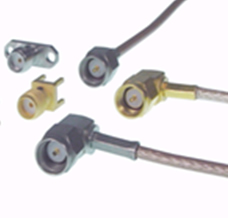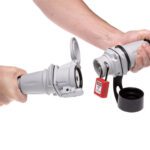Five Things to Know About RF Coaxial Connectors
Think you know everything about RF Coaxial Connectors? Here are five things to know before you start your next design.
1. Radio frequency (RF) coaxial contacts maintain signal integrity.
RF coaxial connectors have historically been used to transmit radio signals over copper lines so the signal can be processed into an audible or visible medium. Two types of processing are commonly employed: Either maintain the analog signal and reproduce or record it in that form, or convert it into a digital signal that can be further processed or recorded. The role of the coaxial contact is to maintain signal integrity, minimize signal emissions, and reduce the impact of external interference. The design of the contact is usually modeled to maximize signal integrity and minimize internal interference and signal loss (attenuation).
2. Many RF coaxial contacts can be used to transmit digital signals directly.
The coaxial contact system design needs to provide adequate shielding to ensure that external signals aren’t picked up by the interior conductor transmitting the signal. Stray signals that are picked up during processing can interfere with the processing of the desired RF signal — usually in the form of noise. The design of the contact must also be properly modeled to maintain signal integrity so the signal can be processed cleanly and either reproduced, translated, or stored. The key element to this design is to avoid signal loss through attenuation. The attenuation of digital pulse trains results in a degradation and distortion of the pulse in terms of loss in peak voltage and slower pulse rise times, commonly measured in decibels. Because signal attenuation is minimized, many RF contacts can also be used to efficiently transmit digital signals.
3. Coaxial contacts can be used in wireless data transmission applications.
A common method of transmitting data wirelessly is to modulate the digital signal into an analog signal and then transmit and receive them on a radio frequency transmission. High-bandwidth coaxial contacts are generally used to maintain signal integrity before and after transmission, allowing the analog signal to be converted to digital, and vice versa. Interestingly, the same contact designs that maintain analog signal integrity also apply to digital, with the exception that the design is generally modified to accommodate both transmit and receive lines as used in Ethernet digital networks. In high-reliability systems, these termini typically house four or more contacts, which enable data transmission rates of more than 1Gb/s.
4. High-reliability connectors protect RF contacts from environmental exposure.
RF connectors that are used with coaxial contact systems are primarily tasked with providing a structure around the contact to enable it to maintain signal integrity, regardless of its surrounding environment. Key elements of high-reliability connectors are the ability to withstand exposure to shock, vibration, liquid intrusion, corrosion, temperature, dust, and dirt. It’s important for designers of RF electrical systems to take into account both physical and electrical elements when creating RF transmission and interconnect systems.
5. High-reliability connectors can accommodate RF, data, and power in a single unit.
ITT Cannon offers a wide spectrum of high-performance (multi-GHz) RF termini for high-reliability connector systems that are suitable for use in severe service environments. The combination of maintaining signal integrity at very high bandwidth and providing the environmental protection of a high-reliability connector package is the hallmark design of effective RF coaxial systems used in space, air, land, and marine vehicle applications, as well as exposed stationary equipment operated in the most punishing environments. Extremely flexible, these connectors enable designers to combine RF, data, and power in a single unit.
[hr]
 Wes Morgan is the director of product management at ITT Cannon and has been with the company for more than 10 years. Morgan has more than 20 years of experience in the aerospace industry, specializing in high-bandwidth interconnect systems. He holds degrees in industrial/data network engineering and business administration.
Wes Morgan is the director of product management at ITT Cannon and has been with the company for more than 10 years. Morgan has more than 20 years of experience in the aerospace industry, specializing in high-bandwidth interconnect systems. He holds degrees in industrial/data network engineering and business administration.






